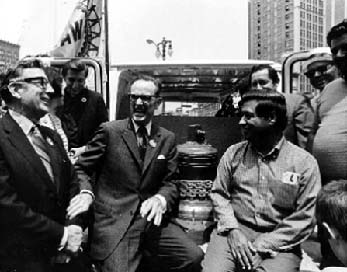 |
| Cesar Chavez receives replica Liberty Bell from UAW,1970 |
Fifty years ago this summer, Cesar Chavez, as leader of the United Farm Workers, launched a nationwide boycott of California table grapes in support of farm-worker rights. His boycott brought attention to the plight of farm workers and his life's work liberated thousands of workers from inhumane wages and working conditions.
One of the most potent symbols of liberty in the United States is the Liberty Bell. When the bell was cast about 250 years ago, words from this week's Torah portion were put on the bell, "Proclaim liberty throughout all the land unto the inhabitants thereof.” (Leviticus 25:10) It seems fitting to call out the bell's links to Torah during American Jewish Heritage Month.
One of the most potent symbols of liberty in the United States is the Liberty Bell. When the bell was cast about 250 years ago, words from this week's Torah portion were put on the bell, "Proclaim liberty throughout all the land unto the inhabitants thereof.” (Leviticus 25:10) It seems fitting to call out the bell's links to Torah during American Jewish Heritage Month.
The Torah verse continues, "each person shall be returned to their family and to what is rightfully their portion.” It was part of a special 50-year restoration -- a jubilee (or "yoval" in Hebrew) -- of property and people.
As to property, the physical world, we are merely caretakers; we cannot own it outright or permanently. Our responsibility is to share it with one another and protect it for future generations.
But what about people? How is it that Torah, which serves as the great inspiration for liberty and justice, permits or tolerates slavery at all? And how ironic is it that the Liberty Bell, which celebrates liberty for landowners who wanted to keep their landed property and slaves from King George, used a passage from the Hebrew Bible that mandates releasing all property rights and liberating all slaves every 50 years!
It is also ironic because Judaism is the spiritual inspiration for much white participation in the U.S. civil rights movement. Jews worked to co-found the NAACP. Rabbi Abraham Joshua Heschel and other Jews marched side-by-side in Selma with Reverend Martin Luther King to bring racial and social justice to African Americans in the south. Rabbi Joe Glaser, Martin Ganz, and other Jews marched side-by-side with Ceaser Chavez to improve racial and economic equity to migrant farmworkers in California.
Heschel, Glaser, and others were inspired by Torah. That same Torah, however, tolerates slavery -- it includes regulations for slave adherence to Shabbat, for humane treatment of slaves, even for the release of slaves. Still, slavery is tolerated. How can the same Torah that inspires such passion for liberty, also tolerate slavery in any form?
The answer, it seems to me, is that a central teaching of Torah is to improve the world around us. To work toward perfecting it. The world that surrounded our ancient ancestors at the times and places described in the Torah thought nothing of conquering lands and treating them and the people in them as property to be kept indefinitely. Or at least until the next conquest, when the land and the people would be subjected a different, but still oppressive, owner.
The genius of Torah, is that it teaches us to make things better by inspiring us to improve the world incrementally. Torah recognizes it is impossible to change the world all at once, to make the entire world and all its residents conform to high ideals for justice and peace overnight.
But we can improve it little by little every day, so that each week we have advanced the world a little more, and every Jubilee, or 50 years, even more.
Perhaps, our ancient ancestors were permitted slaves in the Torah because slavery was pervasive back then. But they were required to release them in the Jubilee year to demonstrate that things could and should be different -- get better – through our actions in the world. We should be challenged by Torah's example of the Jubilee year to find new ways to bring even more liberty to our world. Ways that improve our world a bit at a time.
That same lesson of improvement is taught by the history of the Liberty Bell itself. The bell actually cracked the very first time it was sounded as it was being tested in 1752. Then it was melted down and recast nearly a year later. When that second bell proved defective, it was melted down again and recast to make a third version. Then it was sounded without defect every July 4th and state event for the next 60 years until it cracked again. And while that crack means it cannot be sounded now, we still cherish it as an inspiration to work for freedom and justice.
So it is with Torah, its words condition us to have empathy for those who are oppressed, and exhorts us to work for their liberation and restoration of justice. Even though, for some, it seems there is a crack in the Torah itself; the crack of tolerating slavery. Like the Liberty Bell, the Torah can have a crack and still inspire us to work harder to bring liberty and justice to all.
No comments:
Post a Comment
Comment Here